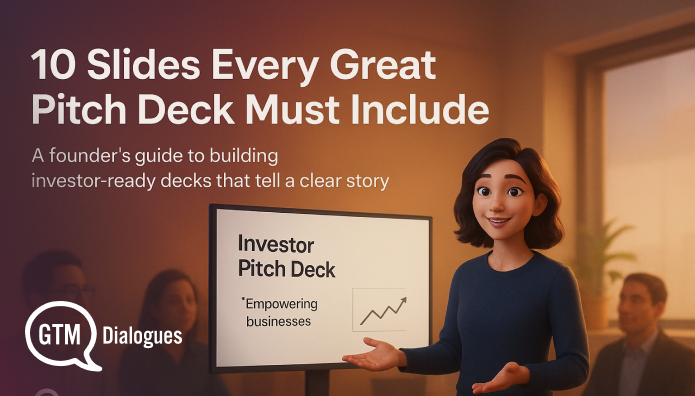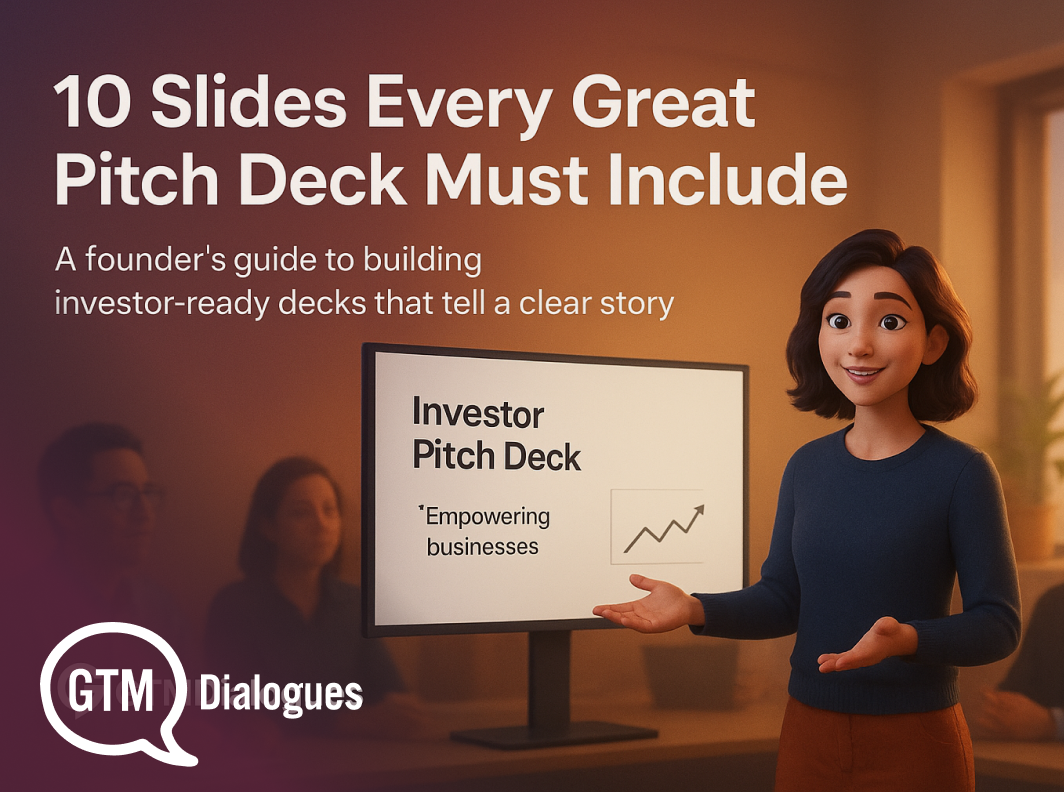Investors review dozens of decks each day, most for less than three minutes. The ones that stand out follow a clear, logical flow that tells a story worth remembering.
A great pitch deck persuades. It balances emotion and evidence, connecting the problem you’re solving with the opportunity you’re unlocking. Every slide serves a specific purpose in guiding investors from curiosity to conviction.
The best decks don’t overwhelm with data or design. They create clarity. They show that the founder understands their market, knows what drives growth, and can communicate it precisely.
This guide walks you through the 10 slides every great pitch deck must include.
Each slide builds on the last, shaping a narrative that demonstrates clarity, momentum, and investor readiness:-
Slide 1: Title Slide / Business Overview
Your title slide is your startup’s opening handshake. It introduces your company, establishes tone, and signals clarity from the first second. Investors should instantly understand what you do and why it matters without reading beyond a single line.

- Include your company name, logo, tagline, and mission statement in one frame. Example: “Empowering logistics businesses to automate last-mile delivery through predictive routing.”
- Write a one-line description of what your business does. Treat it as your verbal elevator pitch, not a product brochure.
- Maintain a minimal, balanced layout with clear typography and subtle use of brand colors. Avoid visual distractions that shift focus from your message.
- Add website, email, and location details at the bottom corner. It helps investors quickly find your contact information.
- Use one contextual visual. A product screenshot, hero image, or illustration that reflects your purpose or industry. It should add clarity, not decoration.
Avoid overused buzzwords like “disruptive,” “revolutionary,” or “next-gen.” Skip long paragraphs about your vision or story. The goal is to communicate professionalism and precision. By the end of this slide, investors should grasp what space you’re in and feel ready to learn more.
Slide 2: Problem
The problem slide defines the “why” behind your startup. It explains the pain point you’re addressing, who experiences it, and why solving it matters now. This slide anchors your entire pitch, if investors don’t believe the problem is real or significant, they’ll stop listening.

- Describe the core pain point clearly and in measurable terms. Example: “60% of small logistics firms still manage routes manually, causing 25% higher fuel costs.”
- Specify who faces this problem - customers, businesses, or end-users. The more specific you are, the more credible your story sounds.
- Quantify how big or urgent the problem is using real data, surveys, or credible market studies. A clear metric or relatable scenario helps investors visualize the pain.
- Use a relatable anecdote or short user story to make the issue tangible. For instance, “A mid-sized retailer spends 10 hours weekly reconciling payments across 5 platforms.”
- Keep visuals simple - a pain chain diagram, a quick chart, or a quote from a customer is enough to humanize the challenge.
Avoid vague statements like “the market is inefficient” or “users are unhappy.” Don’t list every possible issue. Focus on the one or two pain points your startup directly solves. The problem should feel specific enough that investors immediately see the opportunity behind it.
Slide 3: Solution
The solution slide answers the most important question investors ask after understanding the problem. How do you solve it better than anyone else? It should show clear cause and effect: a painful problem met by a practical, scalable solution.
- Present your product or service as the direct, logical answer to the problem stated earlier. Summarize what it does in one or two crisp sentences. Example: “Our AI-based routing software reduces delivery time by 30% through real-time optimization.”
- Focus on outcomes instead of features. Explain how users’ lives or businesses improve after adopting your solution.
- Add a simple visual representation such as a product mockup, short demo GIF, or workflow diagram that makes your value proposition instantly clear.
- Highlight what makes your solution practical and scalable. Mention technology, partnerships, or systems that ensure it can grow with demand.
- Keep tone confident but measured. A slide that feels exaggerated loses credibility faster than one that’s modest but concrete.
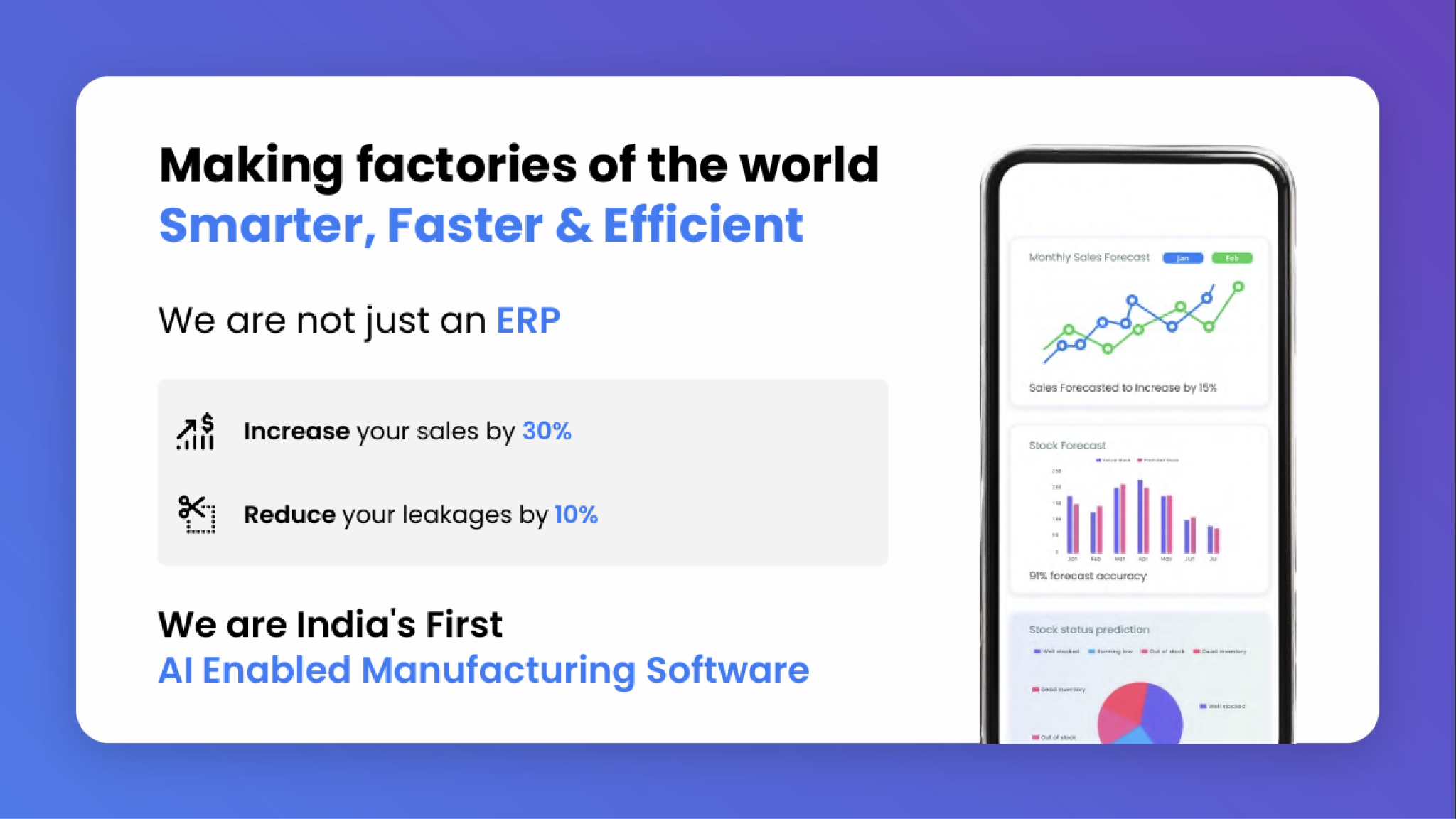
Avoid listing technical specifications, long process explanations, or overly detailed architecture diagrams. The goal here isn’t to show complexity, it’s to make investors think, “This actually solves the problem effectively.”
Slide 4: Market Size and Analysis
Investors fund growth potential, not just good ideas. The market slide quantifies that potential. It shows how large, accessible, and growing your opportunity truly is. A clear market view gives investors confidence that your startup can scale.
- Present the TAM, SAM, and SOM structure:
- Total Addressable Market (TAM): The full demand for your solution globally or across all segments.
- Serviceable Available Market (SAM): The portion of the market you can realistically reach.
- Serviceable Obtainable Market (SOM): The segment you can capture in the near term, based on current resources.
- Use credible data sources such as industry reports, analyst studies, or internal research to back your numbers. Investors value logic over inflated projections.
- Visualize your market with a simple, clean chart such a s a pyramid, concentric circles, or bar graph showing market share potential.
- Identify your core customer segments and their characteristics: industry type, company size, geography, or buyer role. This connects your opportunity to your go-to-market strategy later.
- Mention market trends that support timing: regulatory shifts, technology adoption, or changing customer behavior that make your solution timely.
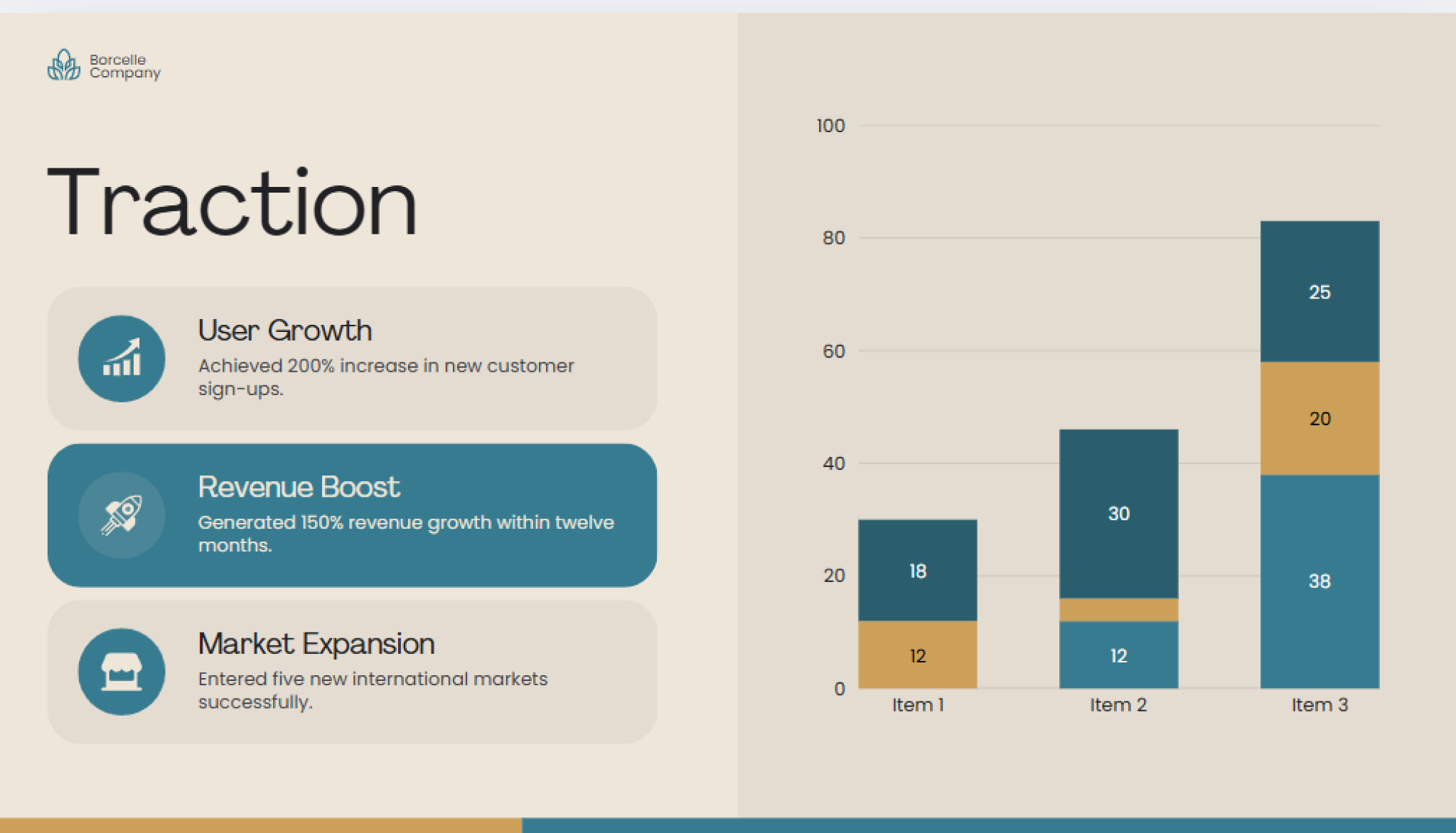

Avoid round-number guesses like “a $10 billion market opportunity” without supporting logic. Skip overcrowded slides with too many statistics or charts. Investors should leave this slide understanding two things clearly: the market exists, and your entry point is focused and attainable.
Slide 5: Product and Business Model
This slide bridges what you’ve built with how it makes money. Investors want to see how your product creates value and converts that value into predictable, scalable revenue. Keep it focused on clarity - what you sell, to whom, and on what terms.

- Describe your product or platform in one or two plain-language sentences. Avoid technical depth and highlight what users achieve with it. Example: “A cloud-based analytics tool that helps e-commerce brands monitor real-time sales and customer retention.”
- Explain your revenue model with subscription, transaction fee, marketplace commission, or enterprise licensing. Specify how and when revenue is realized.
- Outline your pricing logic. Show how pricing aligns with customer value or market norms. For example: “Tiered monthly pricing based on transaction volume.”
- Include a quick overview of your unit economics. Mention contribution margin, customer acquisition cost (CAC), or payback period briefly. This demonstrates financial discipline without overloading the slide.
- Add a small visual element such as a pricing table or diagram showing how revenue flows through your business model.
Avoid buzzword-heavy descriptions like “AI-powered ecosystem” or long technical breakdowns of features. Don’t hide pricing assumptions or leave investors guessing how you monetize. By the end of this slide, your business model should feel both simple and scalable.
Slide 6: Go-To-Market Plan
Your go-to-market (GTM) slide shows how you plan to turn your strategy into measurable customer acquisition. It’s where investors assess your ability to execute, how you’ll reach your audience, convert them, and grow efficiently.
- Outline your customer acquisition strategy in simple stages - awareness, conversion, and retention. Example: “Target SMBs through LinkedIn outreach, followed by free trials and onboarding webinars.”
- List your key marketing and sales channels: paid digital campaigns, partnerships, content marketing, outbound sales, or product-led growth initiatives.
- Highlight your target customer personas who makes the buying decision, what motivates them, and how your approach aligns with their needs.
- Include your sales or rollout timeline, such as milestones for pilot launches, regional expansion, or scaling campaigns.
- Add 2–3 specific goals or KPIs. For instance, “First 1,000 paying users in six months” or “Reduce CAC by 20% through referral incentives.”


Avoid vague statements like “We’ll use social media to grow” or complex marketing funnels filled with jargon. The goal isn’t to show every idea, it’s to prove you have a structured plan to attract, convert, and retain customers at scale.
Slide 7: Competitors
The competitor slide helps investors understand where you stand in the market landscape. It shows that you know your space, respect existing players, and have a clear reason to win. A confident, factual tone here builds credibility faster than claiming “no competition.”
- Identify your main competitors - direct (same target and solution type) and indirect (alternative ways customers solve the same problem).
- Use a simple comparison chart or matrix to show key differences. Columns can include pricing, core features, market segment, or positioning. Keep it visual with less text, more clarity.
- Highlight your unique advantage or moat. This could be proprietary technology, distribution access, domain expertise, or data that others can’t easily replicate. Example: “Exclusive integration with 2,000+ retailer POS systems, enabling faster adoption.”
- Mention how your product fits into the existing ecosystem whether it complements, replaces, or improves on current options. Investors value founders who understand competitive dynamics.
- Support differentiation with proof: awards, partnerships, or measurable customer outcomes that validate your edge.
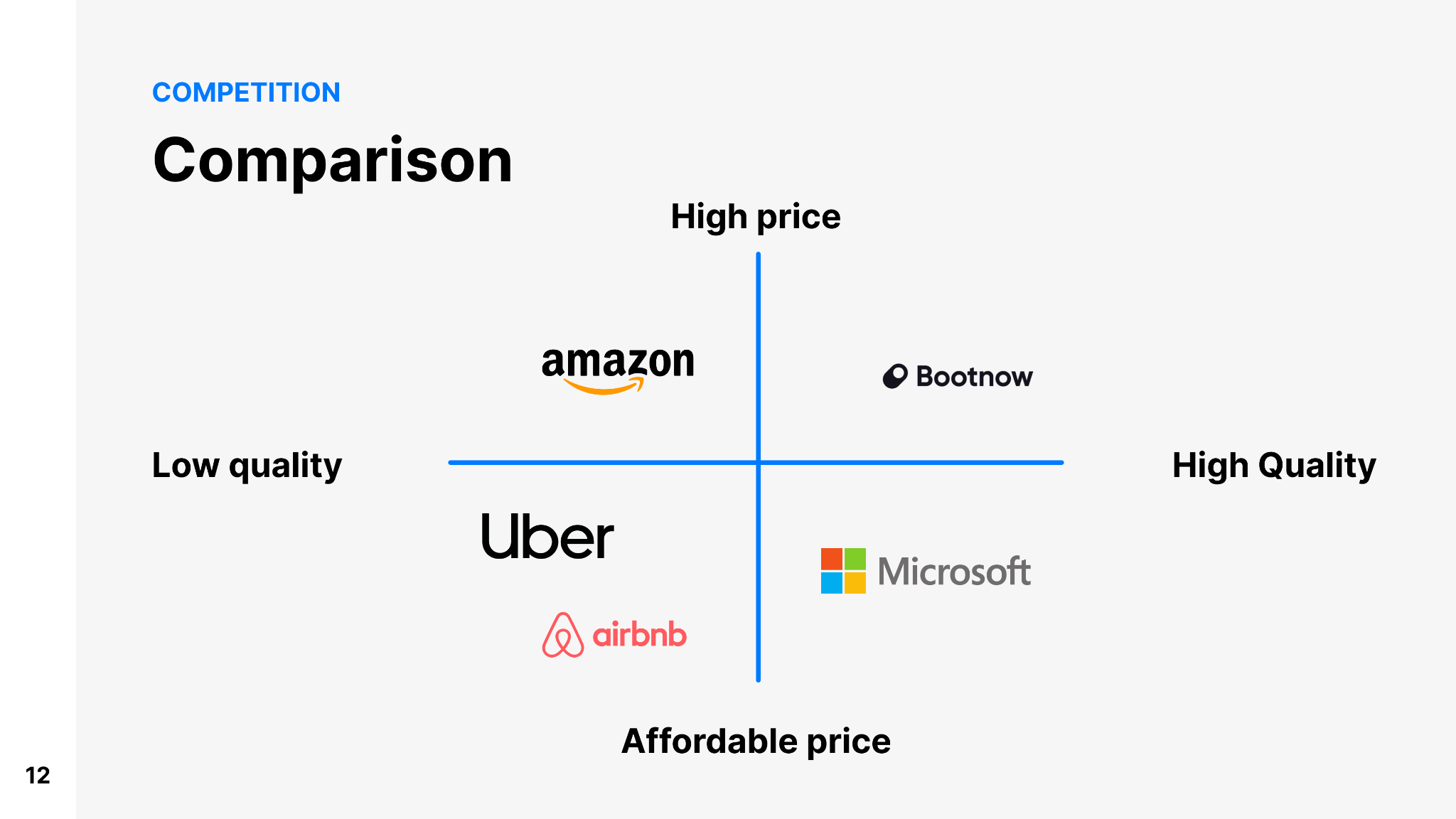
Avoid claiming that you “have no competitors”. It signals limited market understanding. Don’t overload the slide with logos or long feature lists. Your goal is to convey clarity: who else plays here, why you’re different, and how you intend to stay ahead.
Slide 8: Traction / Financials
This slide is proof that your idea works in the real world. Investors look for measurable signals of momentum - growth, engagement, and financial discipline. Even early traction, if presented with clarity, demonstrates execution strength.
- Highlight your core traction metrics such as revenue, customer count, retention rate, or user growth over time. Example: “$450K ARR with 20% MoM growth since launch.”
- Use visual charts or trend lines instead of tables. Growth curves or milestone timelines communicate traction far faster than dense data blocks.
- Include key financial highlights like gross margin, burn rate, or runway. Early-stage founders can include 12–24 month projections with short notes on assumptions.
- Showcase customer validation—renewals, testimonials, pilot results, or case study highlights. Real outcomes speak louder than forecasts.
- Add upcoming milestones such as “Expanding to 3 new markets” or “Launching enterprise version in Q4.” This shows momentum beyond current numbers.
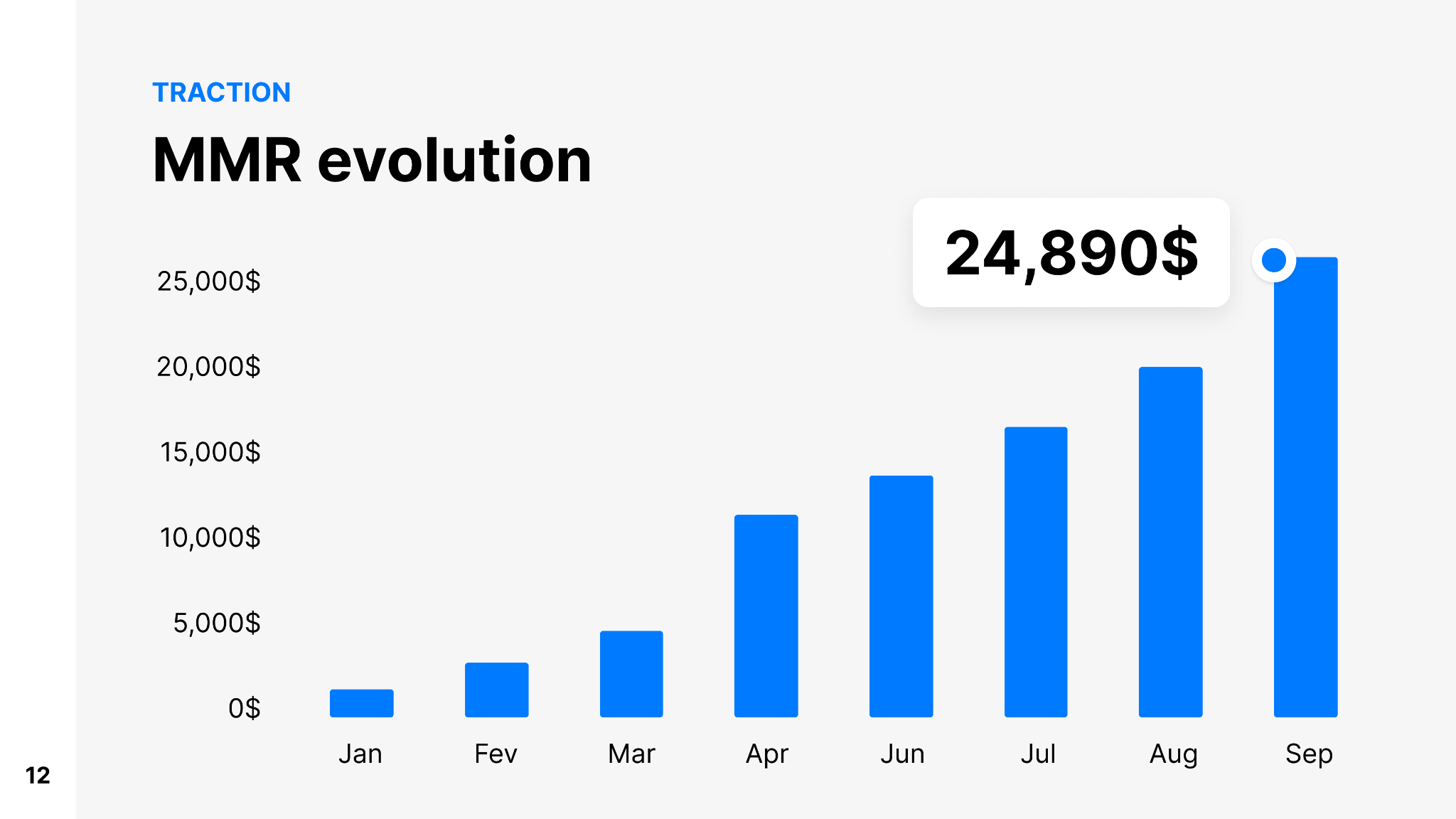
Avoid overcomplicating this slide with too many ratios or financial statements. Don’t exaggerate projections. Investors spot inflated forecasts quickly. Focus on honest, visible progress and disciplined financial management. The message should be simple: this company is moving forward with traction that supports its story.
Slide 9: Team
Investors invest in people first, products second. The team slide gives them confidence that the founders can execute the vision, handle challenges, and scale the company. This slide should communicate credibility, chemistry, and capability in as few words as possible.
- Introduce founders and key leadership members with names, titles, and one-line credentials. Example: “Priya Sharma – ex-Google Product Lead, 10 years in AI-driven analytics.”
- Highlight relevant experience that directly connects to your business—domain expertise, startup experience, or previous exits.
- Mention advisors or board members only if they’re actively engaged and add strategic value, such as industry veterans or investors with domain insight.
- Keep visuals uniform. Professional headshots with consistent formatting convey polish and attention to detail.
- If applicable, add a quick note about team structure or upcoming hires, such as “Next key hire: Head of Sales (Q1 2026).”
Avoid generic bios, unnecessary titles, or listing every team member. Don’t use buzzwords like “passionate,” “dynamic,” or “innovative.” Instead, focus on competence and alignment with your mission. By the end of this slide, investors should feel assured that this team knows what they’re doing and can deliver results.
Slide 10: Ask
The final slide is your moment of clarity. It tells investors exactly what you need, what it will fund, and what it will help achieve. This slide isn’t just about the number—it’s about your plan and confidence in execution.
- State your funding ask clearly. Example: “We’re raising $1.2M to scale product development and customer acquisition over the next 18 months.”
- Break down how the funds will be used for product, marketing, hiring, operations. A simple pie chart or percentage split helps visualize allocation quickly.
- Mention your target milestones tied to this round: “Reach $2M ARR and expand into two new markets by Q4 2026.”
- Include your current status if relevant (seed round, bridge round, or pre-Series A), and note any existing investors or commitments.
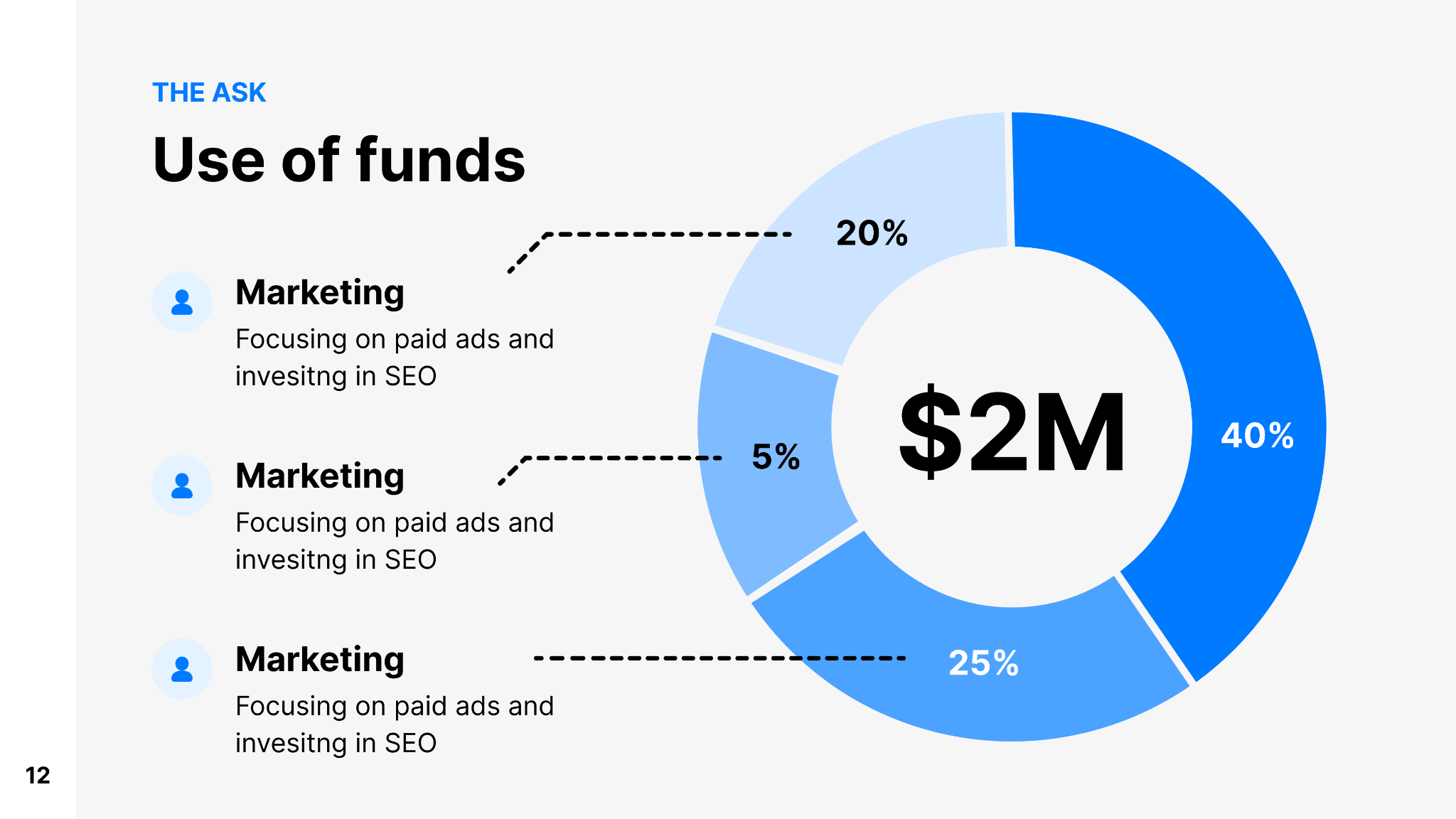
- End with a confident closing line that reflects your long-term vision. Example: “We’re building the next standard in cross-border B2B payments, and this round helps us get there.”
Avoid vague requests like “Looking for funding to grow.” Don’t leave the investor wondering where their capital goes or what progress it enables. The ask slide should communicate precision, direction, and readiness to deploy funds effectively.
Get in Touch with GTMD to Build an Investor-Ready Pitch Deck
Most founders don’t struggle with ideas, they struggle with clarity. Even the most promising startup story can fail to connect if the deck lacks structure, flow, or investor logic.
We’d love to help you there. We help early-stage founders transform complex business narratives into sharp, investor-focused pitch decks that:
- Tell a clear, credible story from problem to potential.
- Align perfectly with your financial model and fundraising ask.
- Balance design simplicity with strategic depth and data clarity.
Our process blends storytelling, market understanding, and investor psychology to help your deck stand out in a crowded inbox, and in the room.
If you’re preparing for your next fundraising round or want expert feedback on your existing deck, let’s make it investor-ready together.
Talk to our team to start crafting a pitch that earns attention, and funding.
Frequently Asked Questions (FAQs)
How long should a pitch deck be?
Keep it between 10 and 15 slides. Ten well-structured slides usually tell your story best without losing investor attention.
Should financial details be in the main deck or appendix?
Include key highlights including revenue, burn rate, and projections in the main deck. Move detailed forecasts, assumptions, or models to the appendix or a separate follow-up sheet.
How much text should each slide contain?
Aim for three to four concise bullet points per slide. Use visuals, charts, and graphics to communicate data faster than text-heavy explanations.
What’s the ideal order if I already have traction?
If you have strong traction, move the Traction slide earlier, right after Solution. Early validation immediately strengthens your narrative.
Do I need separate versions for email and live presentations?
Yes. The emailed deck should be self-explanatory with brief context on each slide, while the presentation deck can rely more on visuals and your verbal narrative.

